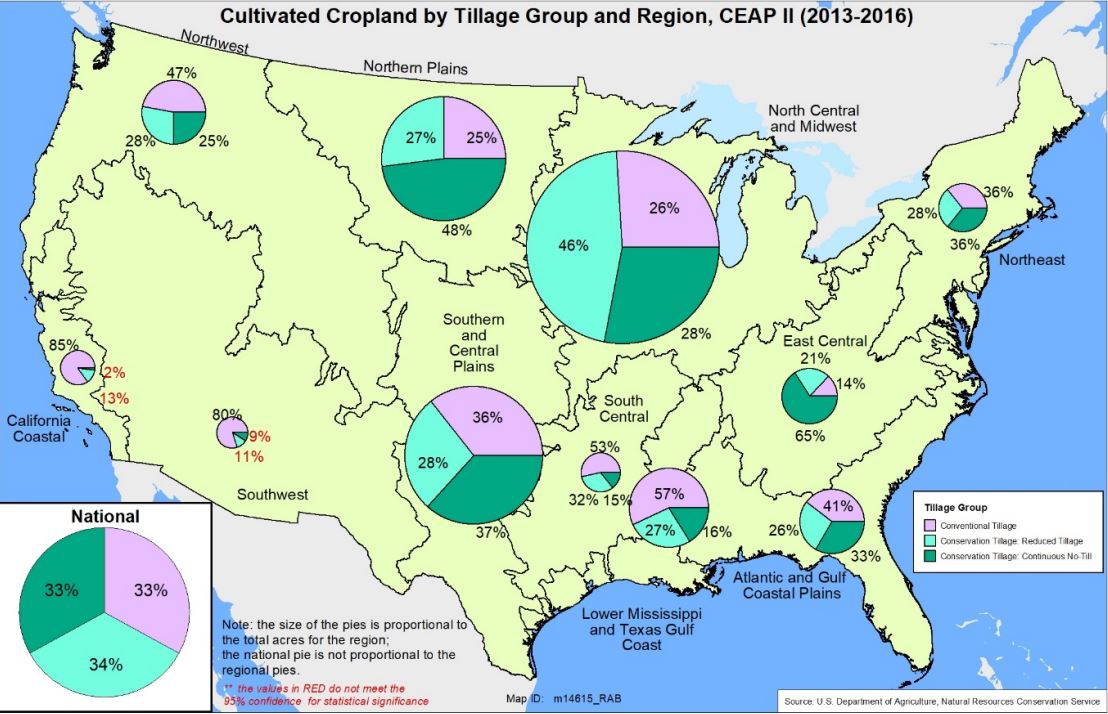In this Ask the Expert, Evelyn Steglich answers questions about the latest USDA report on voluntary conservation outcomes across the nation’s cultivated croplands. Evelyn is the Acting Modeling Team Lead for USDA’s Conservation Effects Assessment Project (CEAP), an effort led by the Natural Resources Conservation Service (NRCS) to quantify the effects of conservation on private, working lands.
NRCS published “Conservation Practices on Cultivated Croplands: A Comparison of CEAP I and CEAP II Survey Data and Modeling” in March 2022. This report provides data on national and regional trends in cropland conservation – and associated effects – over time.

This report has a lot of information. What are the key findings?
The report compares conservation practices and associated environmental outcomes between two farmer surveys – the first conducted from 2003 to 2006 (CEAP I), and the second from 2015 to 2016 (CEAP II). Nationally, during the 10-year period between these surveys:
- Conservation tillage adoption increased by 53.4 million acres. More than 41.5 million of these acres, 33 percent of all cultivated cropland, was continuous no-till.
- Structural practice adoption in combination with conservation tillage increased, illustrating the efforts of farmers to integrate conservation practices to gain the most benefits.
- Cover crops increased from 2 million to nearly 19 million cultivated cropland acres.
- Producers increasingly adopted advanced technologies, including enhanced-efficiency fertilizers and variable-rate technologies.
- Conservation crop rotations increased and were present on more than 219 million cultivated cropland acres by CEAP II.

There were significant effects for natural resources and the environment nationally:
- Average annual water erosion decreased by 76 million tons, or 13 percent.
- Average annual wind erosion decreased by 94 million tons, or 16 percent.
- Cultivated cropland gaining soil carbon increased by 25.7 million acres, or 14 percent.
- Carbon gains on all cultivated cropland increased by over 8.8 million tons per year.
- Average annual fuel use decreased by 110 million gallons of diesel fuel equivalents.
- Subsurface nitrogen losses increased by 420,000 tons, or 13 percent.
- Soluble phosphorus losses increased by 7,200 tons, or 11 percent.
What would you like to tell farmers about these latest findings on conservation across cultivated croplands?
NRCS works with farmers and other land managers to implement voluntary conservation practices across our nation’s working lands. We need data to evaluate successes, identify potential improvements, and set targeted, measurable goals for the future. This is where CEAP adds value.
Cropland farmers can leverage the findings in this CEAP report, along with operation-specific data such as soil test results or yield maps, to strengthen their management decisions.
What is the source of this data?
We use a sampling and modeling approach that leverages natural resource data sources, such as the National Resources Inventory, and national farmer surveys conducted in partnership with USDA’s National Agricultural Statistics Service (NASS). This allows us to account for diverse soils, topography, and site-specific farming activities. Approximately 19,000 farmers provided input on their conservation and management practices for this report.
Based on these findings, what do you identify as target areas for future conservation?
There was a national decline in nutrient management between our two survey periods. We found a 13 percent increase in subsurface nitrogen losses and an 11 percent increase in soluble phosphorus losses. This means more of these nutrients were lost to the surrounding environment instead of being used by crops. It also means farmers are losing money on those nutrients.
Because of this data, we know nutrient management is a target area for improvement and a savings opportunity for farmers. Farmers can get help developing a site-specific Nutrient Management Plan for their land and work toward a more balanced system—one that uses the right source, rate, time, and method for applying nutrients such as commercial fertilizers and manure. This will enable them to save on input costs, optimize crop utilization, and reduce environmental effects.
NRCS offers technical and financial assistance to support diverse conservation goals, including nutrient management. Farmers can contact their local NRCS office to learn more.
Where can I find more information?
Here is the CEAP report and summary of findings. The NRCS webpage has more information on CEAP.
Evelyn Steglich is the Acting CEAP Modeling Team Lead for the NRCS Resource Inventory and Assessment Division. She can be reached at evelyn.steglich@usda.gov.


